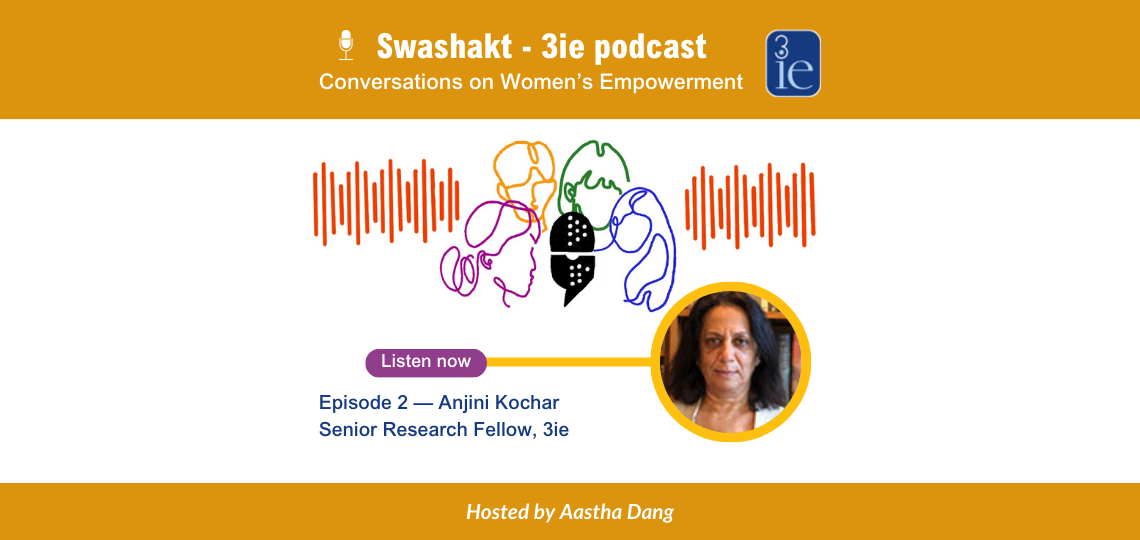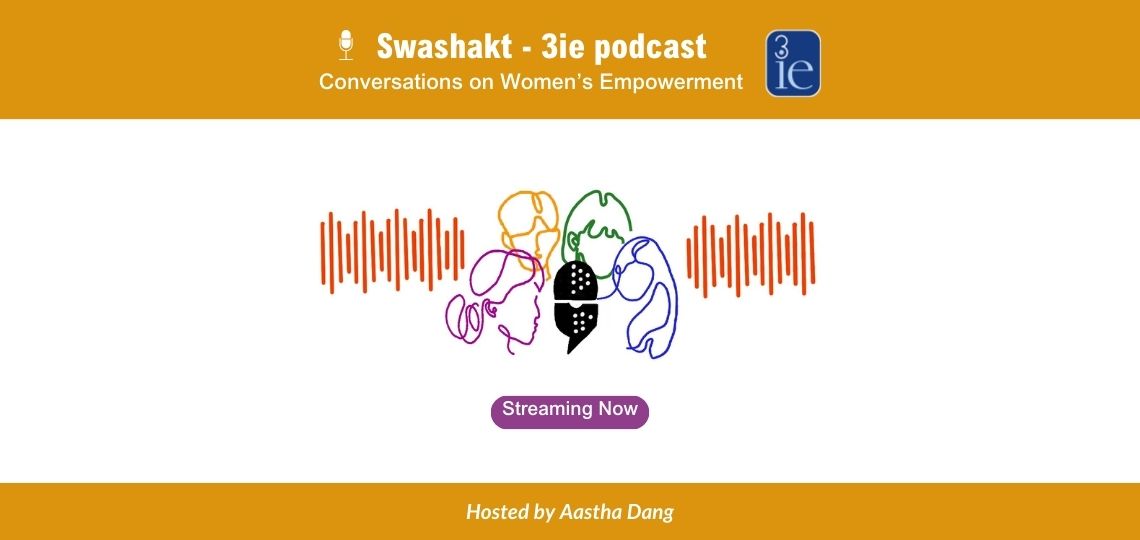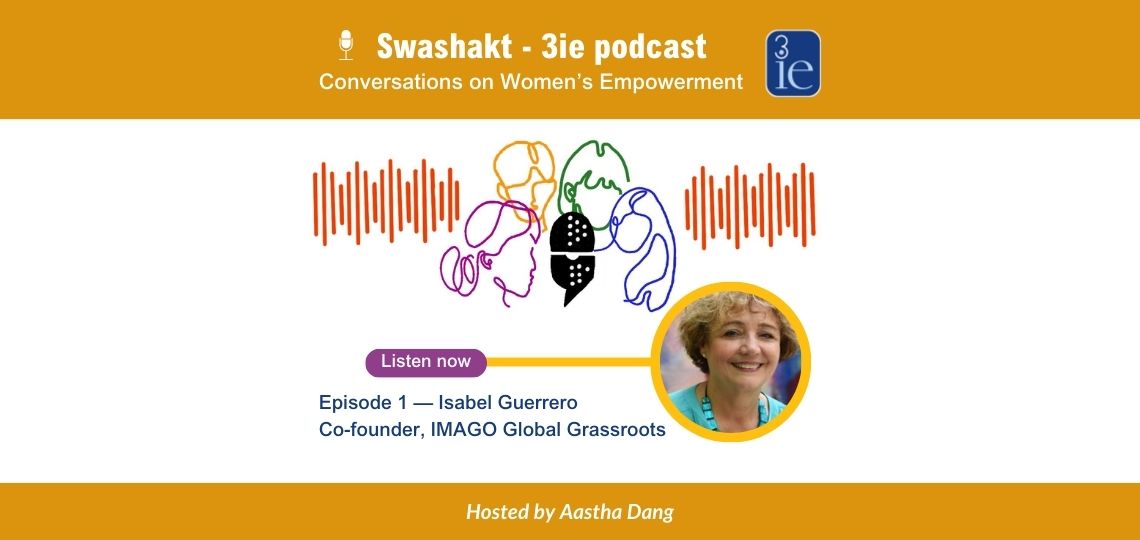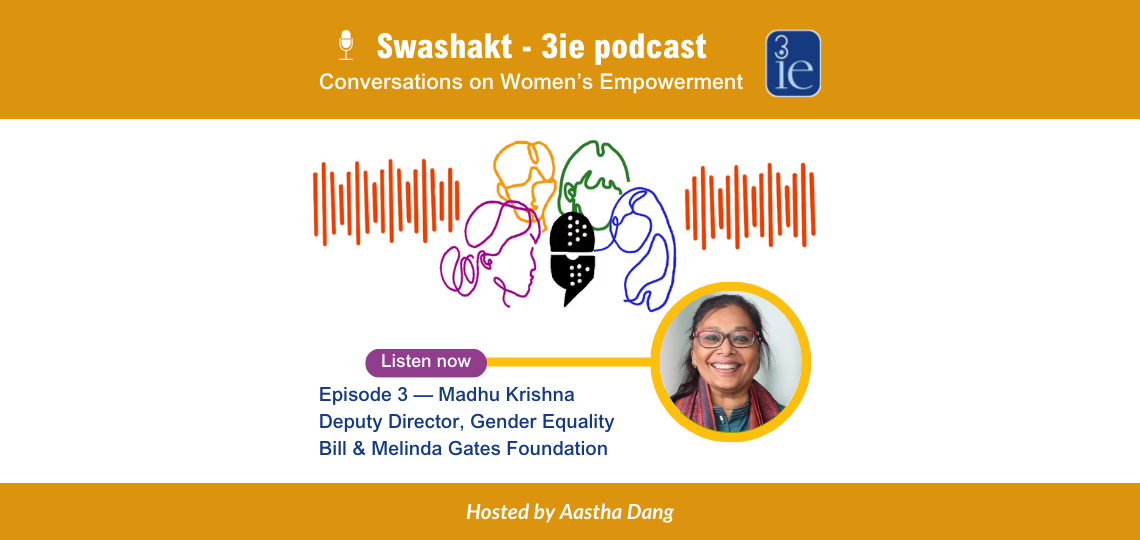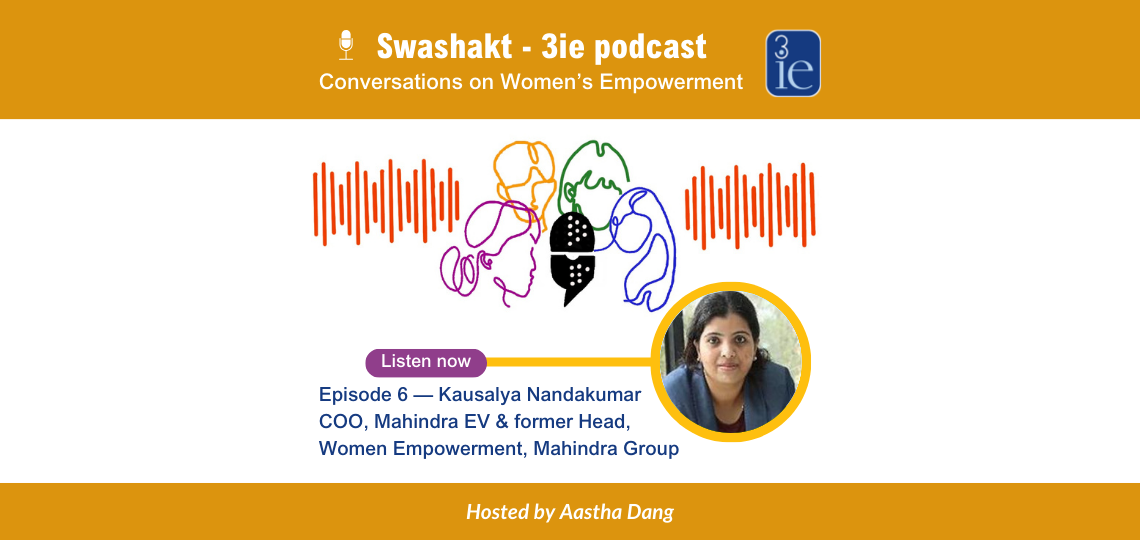Social relationships and new opportunities – with Anjini Kochar
About the episode
In episode 2 of the Swashakt podcast, 3ie evaluation specialist Aastha Dang speaks to Anjini Kochar, a senior research fellow at 3ie who has been leading the evaluation of the Government of India’s National Rural Livelihoods Project. Kochar says empowerment of women is linked to their choice and voice and behind these is a set of power relationships. Listen in to find out more.
This podcast series has been produced by the International Initiative for Impact Evaluation (3ie) and is inspired by our Swashakt evidence program and our Rural India Livelihoods Project. The views expressed are those of the speakers and do not necessarily reflect positions or policies of 3ie.
Host: Aastha Dang
Production lead: Kirthi V Rao, Tanvi
Production support: Annie Vincent, Durgadas Menon, Shailendra
Disclaimer: The podcast has been edited for clarity.
[Intro]
Aastha: The world is not on track to achieving Sustainable Development Goal #5 on gender equality and women's empowerment. Where have we reached and how far do we need to go? While data can throw light on this question, there is no substitute for the wisdom of practitioners. Join us for this podcast series as we try to understand empowerment better and explore the pathways towards economic empowerment, in particular self-empowerment for women who are part of collectives in low- and middle-income countries. We are talking to a series of women whose training and experience can act like beacons on this journey. I'm Aastha Dang, Evaluation Specialist at 3ie. In today's episode. I have Anjani Kochar, who is a Senior Research Fellow at 3ie and has been the Director of the India Program at the Stanford Center for International Development.
[Interview begins]
Aastha: Welcome to this Swashakt podcast, Anjini and I'm going to straight jump into the questions now. So my first question to you is whom do you see as an empowered woman?
Anjini: Firstly, thank you for having me as part of the series. I'm delighted to be a part of it. The question is of course a great question. I think the way it is conventionally described now in the literature and policy circles. Empowerment of women has to do with choice and with voice, and behind these is a set of power relationships. But when I think about it, I tend to think of it in more economic terms. So that's the framework that comes most easily for me. The economic framework again does emphasize choice, but writes of them, you know, describes them as preferences. It does talk about voice as well, but voice is described in economics in terms of women's bargaining power. And so bargaining power is specific to the institution that is of concern... and it is determined by your exit option in that institution. So, in a marriage, for example, the exit option would be how well off are you if you were not married. And that sort of determines whether you have an exit option. But there's the same description of, you know, choice and voice in there.[The role income plays]
What the economics literature emphasizes is something that is sometimes missing, and that's the importance of opportunity sets, which is income and the role income plays. And the best way I think to describe that is if you are poor and if you are struggling to meet entitlements, then questions of preferences and women's empowerment just don't arise. You do whatever is necessary. And I think that does get lost because we do have to first make sure that people do have these minimum means. Once you have that, you can start talking about preference. It doesn't mean that you should focus on income without thinking about women's empowerment. I think that is a given. But the recognition that choice is something that may come later is something I want to emphasize. If you don't do that, then there's this possibility that you sometimes mistake income and lack of income for choice. So, an example to illustrate that we hear very often that you need to give income to women because when you do so, women spend goods differently from men. Women have a different set of preferences than men. And the best example often given of that is that women prefer to spend on children compared to men. And that's one important reason for targeting women.
[Narrowing opportunities and women’s preferences]
Anjini: So yes, it is true. If you ask a woman in any given village in India, you know you're going to get this increase in savings, what do you want to use the savings for? And they'll invariably answer: we want to use it to promote our son's business, we're going to buy him a taxi so he can participate in that or we're going to put the money into our children's education. And that's, you know, a clear statement about women's preferences. But if you follow up with a second question and the second question would be: why don't you use that savings instead to invest in your own income and then use that for your children? And if you ask that second question, you get a very different response. And very frequently the response is, from women who are in the 35 to 40 age bracket, the response is: my life is done, there's nothing I can do to improve my life. And so I'm going to give it to my children. That's really different. And that's basically saying: my income opportunities are limited. Whatever opportunities that I had, that window closed when I was 25 and now what I can do is invest in my children. You know, when you don't think of it in that sense, you do end up with this: Okay, Let's promote women because it's fantastic they are doing this for their children. But we have a set of very narrow economic opportunities for women, which obviously goes into their empowerment, which we don't always think about or consider.
[Social relationships and how to organize groups]
Aastha: Anjini, that was so powerful! You know what you said about this narrow window of opportunity that women have and how they conceive, you know, empowerment to be of such a narrow window of opportunity. This brings me to my next question. What, according to you, is the link between women's collectives and their empowerment?
Anjini: This is a question I was hoping would come late in this thing because it's going to sidestep a lot of other interesting points. But if the question is about groups, social groups and how do social groups affect women and enterprises or being a part of that, there's broad recognition and I think broad agreement amongst... This is a new idea of the past ten years in terms of the emphasis it's getting, at least in the economics profession. This is an old idea that's coming from sociology that basically our social relationships determine economic outcomes. So and you have to pay attention to social relationships to have an impact on income. So again, in a way that would make the most sense for you and me, we all use our social networks extensively in learning about jobs, job interviews, finding out new opportunities, etc. So that's what the emphasis says, OK, we know that these social relationships really matter for improving incomes going forward. So, can we develop the same sort of social relationships for women? And that I think is the genesis that let's involve them in groups. And put them into these self-help groups. So once you have that, the question is not that you know, can enterprises have an effect or can self-help groups have an effect. The question really becomes what sort of groups do we need, how do we organize groups? Again, I think we need to be pushing much further in the research than we have.[Making the group sustainable and successful]
Anjini: The right question is not, you know, can enterprises affect income? You know, can I run an impact evaluation and show you that I started an enterprise and had an effect. The right question really should be about how do we organize an enterprise to get to the goals that we need and the goals could be very different. So suppose I have organized an enterprise that is geared towards improving income. The first thing is that you think it would have to be full of vertical linkages. We need to be connecting people at different levels of income and different levels of expertise so that there can be all these spillovers between them. But if you do have that, then you also have to ask, well what's or how specifically am I going to increase their income and what is the form that's best suited for it. So, I've got this group of women together, say about 40 or 50 women. Do I start producing together? Do I start marketing together? You know what exactly is the objective?
That's one thing. And so, you know, that sort of gets to this question of how do we make enterprises more effective? But the other part of it is we also have to pay attention to the enterprise. So think of yourself in a group of 50 women who are working towards some goal. Will that group sustain? What is going to make it powerful? How do we prevent people from exiting? How do we keep people interested in the group? How do we make sure that the most influential people don't just exit because there's no value in it for them? So recognizing the incentives that go into your making a successful group and working towards that is really important. Specifically on enterprises, the emphasis has always been on this free rider problem and that free riders can really erode the sustainability of a group. But yet when we put together an enterprise, we rarely think of that. We don't think of the incentives of the people in play and how do we make this sustain.[Focus on what makes implementation work]
Aastha: Thanks Anjini. My next question would be are there some women's empowerment interventions that you feel we know enough about but they are yet to be seriously implemented?
Anjini: It's not a question of, you know, what do we know about and what we don't. So that I know is something that is very common again in the academic literature and from the academic literature it's gone over to the policy literature and there the statement is, you know, let's just invest in what we know works. So the emphasis is what works and let's invest in it. Very often we know that something doesn't work because of the implementation. There's some implementation problems and then the view is, well, we need an 'as is' situation. This is how the world is, as is, this is how the world is. So we need to work around that and just to say that, you know, government is not functioning, so we need to take that into account. So then we shouldn't invest in these projects if we know aren't functioning.I take a different view and I feel that what we really don't know about or are not pushing hard enough, is on the implementation side. If a project doesn't work and it's not working because of implementation, it doesn't mean it's not a good project. It means that you need to be spending a lot more time thinking about implementation. So rather than identify projects that work or not, I would say our focus really needs to be on implementation and finding out the institutional arrangements that make implementation work.
The National Rural Livelihood Mission is the project I've been involved in for a long time. It is a great example of that. Its predecessor program was SJSY. So SJSY and NRLM have the exact same objective and nothing else, you know, apart from women's livelihoods and promoting women's livelihoods. What changed between SJSY and NRLM was just implementation. The set of institutional arrangements that were put in place as a result of which NRLM was much more effective, is much more effective than SJSY. It is a long response to your question, but I hope it makes a point that it's not that you know, you should have to list of projects that work and can be implemented. The same projects may not work somewhere else because of the arrangements, institutional arrangements. And that's the one, that's what we should be focusing on.[Government action makes huge difference]
Aastha: You know, you just gave the NRLM example, which is so cogent. But I want to understand what is the key stumbling block, according to you, for promoting empowerment.
Anjini: You know, scope and range of private sector investments or of public sector programs. If this is about private sector programs and public sector programs, I would have to say a government. Just because a lot of what you're talking about, especially when you're talking about empowerment, those are there's a bunch of social goods that come in there. These are goods that have huge spillovers or otherwise the goods in which social returns far exceed the private returns. And because of all this the government is obviously the best player for that because of social returns, expertise, spillovers, etc. But so, I would say that yes, we need investment by the government. I would actually, again a personal, you know, long passion of mine is it has to be in education at a very young age. So, it's really primary education, the quality of education. But again a point that's worth emphasizing, it's the government action can make a huge difference. Government inaction is devastating. It's asymmetrical. And the reason government inaction is devastating... schooling is the example I'll give, but it sort of extends out everywhere. If government fails to act in schooling, private schooling steps in. And what private schooling ends up doing is segregating the country. So you'll have a private school that caters to one group, you know, religious group or not, or a private schooling that caters to upper castes and not lower castes. As a result of which society gets segregated and incredibly polarized. And once it does, we set every social agenda back, including women's empowerment. I've talked about these vertical linkages we need in society to get women empowered, that come from education, but it's not going to come from education if it's not, you know, if society is so polarized that everyone's getting educated in their own space.[Link between economic empowerment and overall empowerment]
Aastha: I'm going to go back to the first question because I'm still mulling on it, where you link financial inclusion and economic empowerment. And I want to understand how does specifically you know financial inclusion and economic empowerment link up with women's overall empowerment in your opinion?
Anjini: So this is going to be a slightly detailed response. Again, I hope that's OK. The way to think about it is, again going back to an exit option, which I think is really what lies behind bargaining power and empowerment in many cases. So I'm going to talk specifically about marriage, though this of course would extend to other areas. So you think of a woman as coming into a marriage, and if I took like a linear scale, this is the value she gets from the marriage, and this is where she would be without marriage. So the difference is this marriage surplus and her bargaining power is not going to increase unless she's hitting this (the value from being without marriage exceeds the value she gets from marriage). Then the husband will realize, oh. you know, I better stop paying attention to her because she can quit the marriage because she's so close to it (laughs). But until then, if you have this very large marriage surplus, and that really is what is the case for women, they enter into a marriage with marriage defining their whole lives. If they exit from the marriage, they, you know, economic, social, everything closes up for them. So they enter with this weak, marriage surplus. Now I give them access to a self-help group and a loan of ₹4000 go up to 10,000 even. That's going to shift this from here to here. So it's going to reduce the marriage surplus a little bit. It's not going to touch here (where the value of being unmarried exceeds the value of being married). And until it does, financial empowerment and economic empowerment are not going to have an effect on women's empowerment. So it doesn't.
I don't want to give the wrong impression that income improvements or even this access to loan doesn't benefit women. It does. They're better off because they can borrow. They're better off all that. But that benefit is the same as just having an increase in income. That benefit would have happened if nothing had happened for women and if men had had an increase in income. That increase in household income is going to make everyone in the household better off. But if you're talking specifically about empowerment and how does women's financial inclusion help it, it doesn't help it unless you move to this threat point or this exit option. That's true for the vast majority of women, but there is one group of women who unambiguously is better off. That group is the women who are yet to be married. Adolescent girls who will enter into the marriage market because when they do, they're going to enter with a greater, you know, less of a marriage surplus going to enter, having moved closer to the exit option. And that again, unfortunately, when we do our research studies, we never pick up on that, that the biggest benefit of any financial inclusion program is on this group of women who are not yet married. But that by itself justifies everything we do on that front.[Opportunity to do something significant]
Aastha: You have been working in the sphere of women's economic empowerment for so long now. My final question to you is what is it that excites you about promoting women's economic empowerment?
Anjini: That's a personal question, I guess, but I wouldn't put it so much as... it is excitement because I think there's an opportunity to do something quite tremendous. The world has changed, India has changed in many ways, and I really do feel that we have this option to do something quite significant and I use the word ‘tremendous’ but my children always tell me that I'm given to exaggeration. So I'm trying to tone it down a little bit and just say that I think we really have the possibility of doing something very significant for women and that definitely excites me.
A large part of it and I'm sure it's the same for you as well, it is passion. You know, for you and I. we grew up in, you know, before you but in a family and in circumstances that you take empowerment for given. Yeah. I have never had to question, you know, do I have value? What are my choices? Can I do what I want to? And recognizing that, I think has been a large part of my journey, just how privileged I've been. And obviously the goal or the objective, I think, for all of us would be that every woman in India should have that same feeling that what she can do should not be defined by where she was born. Or you know, where she has come from. So that I think that's sort of feeling that I owe it almost in a way to give back what I have, you know, been such a huge beneficiary of is something I think that goes along with the, the sense that we really are at the cusp of being able to do something quite significant.
Aastha: Thanks, Anjini. This was beautiful, you know, especially how you connected your own personal journey with your work in women's economic empowerment. Thank you so much for joining us today.
